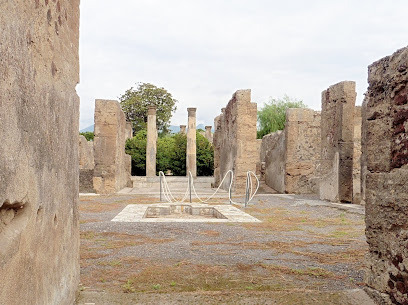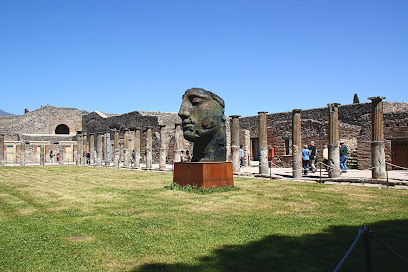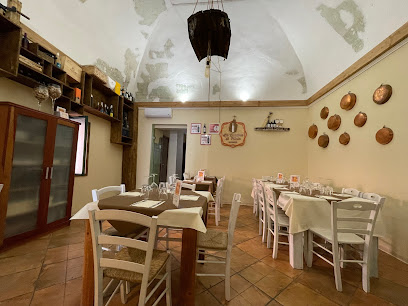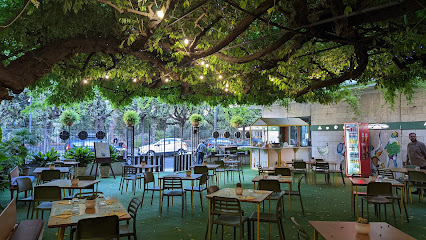
The Majestic Building of Eumachia: A Timeless Monument in Pompeii
Discover the Building of Eumachia in Pompeii, a stunning monument that reveals the city's rich history and architectural brilliance.
The Building of Eumachia in Pompeii stands as a magnificent testament to the city's rich history and architectural prowess. This grand structure, dedicated to the goddess of fertility and the patroness of the cloth industry, offers visitors a glimpse into the vibrant life of ancient Pompeii. Its impressive facade and historical significance make it a must-visit for any traveler exploring this archaeological wonder.
A brief summary to Building of Eumachia
- Pompei, Metropolitan City of Naples, 80045, IT
- Visit website
- Monday 8:30 am-7 pm
- Tuesday 8:30 am-7 pm
- Wednesday 8:30 am-7 pm
- Thursday 8:30 am-7 pm
- Friday 8:30 am-7 pm
- Saturday 8:30 am-7 pm
- Sunday 8:30 am-7 pm
Local tips
- Visit early in the morning to avoid crowds and experience the site in a more tranquil setting.
- Consider hiring a local guide to gain deeper insights into the history and significance of the Building of Eumachia.
- Take your time to explore the surrounding area, as there are many other fascinating ruins in close proximity.
- Make sure to wear comfortable shoes, as the cobblestone pathways can be uneven.
- Bring a camera to capture the stunning architecture and unique details of this ancient site.
Getting There
-
Walking
If you are at the Pompeii Archaeological Park entrance, exit the main gate and turn left onto Via Villa dei Misteri. Walk straight for approximately 500 meters until you reach the intersection with Via dell'Abbondanza. Turn right onto Via dell'Abbondanza, and continue walking straight for about 300 meters. The Building of Eumachia will be on your left, just before you reach the Forum.
-
Walking
From the Amphitheater of Pompeii, head north towards Via dell'Abbondanza. Once you reach Via dell'Abbondanza, turn left and walk along this road. After about 800 meters, you will arrive at the intersection with the Forum. The Building of Eumachia will be located on your right side, adjacent to the Forum.
-
Walking
If you are near the House of the Tragic Poet, exit the house and head west towards the Forum. Walk straight for about 200 meters, and when you arrive at the Forum, the Building of Eumachia will be directly in front of you, on the north side of the Forum.
Discover more about Building of Eumachia
Iconic landmarks you can’t miss
Casa di Romolo e Remo
0.2 km
Discover the Casa di Romolo e Remo in Pompei, an iconic historical landmark that captures the essence of ancient Roman civilization.

Triangular Forum
0.2 km
Experience the historical allure of the Triangular Forum, a stunning monument in Pompei that showcases the grandeur of ancient Roman architecture.

House of the Tragic Poet
0.2 km
Uncover the artistry and history of the House of the Tragic Poet, a must-visit archaeological site in Pompeii that reveals the grandeur of ancient Roman life.

House of Pansa
0.2 km
Explore the House of Pansa in Pompeii, a stunning archaeological site showcasing Roman life through exquisite frescoes and architecture.

Antiquarium di Pompei
0.2 km
Explore the Antiquarium di Pompei and uncover the fascinating history and artifacts of ancient Pompeii in this immersive archaeological museum.

Temple of Isis
0.2 km
Explore the Temple of Isis: A glimpse into ancient Roman spirituality and architecture at Pompeii's historical gem.

House of the Faun
0.2 km
Explore the House of the Faun, a stunning Roman villa filled with captivating mosaics and lush gardens, where history comes to life in Pompeii.

Teatro Grande
0.2 km
Uncover the historical richness of Teatro Grande in Pompeii, an iconic Roman theater steeped in ancient culture and architectural beauty.

Casa della Fontana Grande
0.3 km
Explore the exquisite Casa della Fontana Grande, a historical gem in Pompeii that showcases the grandeur of ancient Roman architecture.

Suburban Baths
0.3 km
Uncover the rich history and architectural splendor of the Suburban Baths, a must-visit archaeological site in Pompei, Italy.

Piazza Esedra
0.3 km
Discover the allure of Piazza Esedra in Pompei, where history meets vibrant local culture amidst stunning architecture and delightful cafes.

The House of Caecilius
0.3 km
Explore The House of Caecilius in Pompeii, a stunning historical landmark that brings ancient Roman life to life with its exquisite frescoes and rich architectural heritage.

Teatro Piccolo
0.3 km
Experience the magic of live performances at Teatro Piccolo, a cultural treasure in the heart of Pompei, Italy, steeped in history and artistic flair.

Quadriporticus of the theatres
0.3 km
Explore the majestic Quadriporticus of the Theatres in Pompeii, a stunning architectural gem showcasing ancient Roman artistry and culture.

House of the Dioscuri
0.3 km
Discover the House of the Dioscuri in Pompeii: A breathtaking archaeological site that reveals the splendor of ancient Roman life through stunning frescoes and architecture.

Unmissable attractions to see
Tempio di Vespasiano
0.0 km
Discover the ancient beauty of Tempio di Vespasiano in Pompei, a remarkable archaeological site showcasing Roman architectural brilliance.

Sanctuary of Lari Pubblici - Excavations
0.1 km
Explore the Sanctuary of Lari Pubblici in Pompeii, a captivating monument that reveals the spiritual life of ancient Romans amid stunning archaeological wonders.

Centauro di Igor Mitoraj
0.1 km
Explore the Centauro di Igor Mitoraj, a stunning sculpture in Pompeii that beautifully merges ancient history with modern artistry.

Foro di Pompei
0.1 km
Explore the timeless ruins of Foro di Pompei, where ancient history and stunning architecture come to life in a UNESCO World Heritage site.

Macellum
0.1 km
Discover the Macellum in Pompeii, an ancient marketplace revealing the vibrant life of the Roman Empire through its stunning architecture and rich history.

Comitium and Municipal Buildings
0.1 km
Explore the historic Comitium and Municipal Buildings in Pompeii, where ancient Roman life and breathtaking views of Vesuvius await.

Santuario di Apollo
0.1 km
Explore the Santuario di Apollo, an ancient sanctuary in Pompeii, revealing the city's rich spiritual heritage and architectural marvels.

Temple of Giove - Excavations
0.1 km
Explore the Temple of Giove in Pompeii: a breathtaking ancient monument showcasing the grandeur of Roman architecture and religious heritage.

Granaries of the Forum
0.1 km
Explore the Granaries of the Forum in Pompeii – a remarkable glimpse into ancient Roman life and architecture amidst ruins.

Arco di Nerone
0.1 km
Discover the Arco di Nerone, a breathtaking historic arch in Pompei that reveals the grandeur of ancient Roman architecture amidst captivating ruins.

Pompei: cardi e decumani
0.1 km
Uncover the mysteries of ancient Roman life at Pompeii, a UNESCO World Heritage site, where history comes alive through remarkably preserved ruins.

Basilica
0.1 km
Explore the Basilica of Pompeii, an architectural marvel that unveils the rich tapestry of ancient Roman life and its enduring legacy.

Casa del Cinghiale
0.1 km
Explore Casa del Cinghiale, a historical landmark in Pompei, and immerse yourself in the rich cultural heritage of ancient Rome.

Lupanar Grande
0.1 km
Discover the captivating history of Lupanar Grande, an ancient Roman brothel in Pompei, showcasing stunning frescoes and artifacts of a bygone era.

Lupanare di Pompei
0.1 km
Explore Lupanare di Pompei, the ancient Roman brothel, and uncover the intriguing stories of love and life in Pompeii's vibrant past.

Essential places to dine
Ristorante Suisse
0.3 km
Experience authentic Italian cuisine at Ristorante Suisse in Pompei, where flavor meets tradition in a charming setting.

Ristorante pizzeria Turistico
0.3 km
Experience authentic Italian flavors at Ristorante Pizzeria Turistico near Pompeii's ancient ruins.

Caupona Pompeii
0.3 km
Experience authentic Roman cuisine at Caupona Pompeii—where every meal tells a story of ancient culinary traditions.

Shaval
0.3 km
Discover authentic Italian flavors at Shaval in Pompei—home to delicious pizzas and traditional dishes crafted with love.

Hortus Pompei, Restaurant & Garden Bar
0.4 km
Discover Hortus Pompei: A charming garden restaurant offering authentic Italian cuisine amidst the historic beauty of Pompeii.

Vesuvio
0.4 km
Experience authentic Italian cuisine at Ristorante Il Vesuvio in Pompei - a must-visit for pizza lovers and culinary enthusiasts alike.

Caupona Pompei Ristorante
0.4 km
Experience authentic Italian cuisine at Caupona Pompei Ristorante near Pompeii's historic ruins—where every meal is steeped in tradition.

Ventuno grammi - anima in cucina
0.4 km
Experience authentic Italian flavors at Ventuno Grammi - Anima in Cucina, where every dish tells a story of tradition and passion.

So Zen Mediterranean Restaurant & Arabian Lounge Bar
0.5 km
Experience exquisite Mediterranean flavors at So Zen Restaurant & Lounge Bar in Pompei - a perfect blend of dining and relaxation.

Ristorante Tiberius Pompei
0.6 km
Experience authentic Italian cuisine at Ristorante Tiberius in Pompeii - where history meets exceptional dining.

Ristorante Pizzeria IMatti
0.6 km
Experience exquisite Italian flavors at Ristorante Pizzeria IMatti in Pompei—home to mouthwatering pizzas and authentic regional dishes.

La cantina di Plinio
0.7 km
Experience authentic Italian cuisine at La Cantina di Plinio in Pompei – where every meal tells a story steeped in history.

Varnelli Pizzeria Bistrot Ristorante
0.8 km
Discover authentic Italian flavors at Varnelli Pizzeria Bistrot Ristorante in Pompei – where delicious pizzas meet inviting ambiance.

Ristorante Anfiteatro
0.8 km
Experience authentic Italian cuisine at Ristorante Anfiteatro in Pompei – where tradition meets flavor in a family-friendly atmosphere.

Stuzzico By Lucius
0.8 km
Experience authentic Italian cuisine at Stuzzico By Lucius in Pompei – where tradition meets flavor.

Markets, malls and hidden boutiques
See Pompeii
0.2 km
Explore See Pompeii for unique souvenirs that capture the unforgettable spirit of this ancient Roman city.

Cellini Gallery Cameos & Corals
0.3 km
Discover exquisite handcrafted cameos and coral jewelry at Cellini Gallery in Pompei, a treasure trove of Italian artistry and heritage.

B&B Domus Vettii Pompei
0.7 km
Experience the charm of Pompei at B&B Domus Vettii, your perfect base for exploring ancient ruins and indulging in local delights.

Mida Sport
0.7 km
Discover Mida Sport in Pompei – your ultimate destination for quality sporting goods, perfect for athletes and adventurers exploring Italy.

Pipol
0.7 km
Discover unique fashion treasures at Pipol, a boutique in Pompei offering a blend of local craftsmanship and contemporary style.

Casa Dei Vettii B&B
0.7 km
Discover the enchanting Casa Dei Vettii B&B in Pompei, where comfort meets history just moments away from the ancient ruins.

Boutique Demil Di Emilia Di Paolo
0.9 km
Discover exquisite Italian fashion at Boutique Demil Di Emilia Di Paolo in Pompei, where style meets heritage in a charming setting.

Pasticceria De Vivo since 1955 in Pompeii
1.0 km
Experience the rich flavors of Italy at Pasticceria De Vivo, Pompeii's beloved cake shop, offering delightful pastries, gelato, and coffee.

roberta falco shop
1.1 km
Explore the stylish offerings at Roberta Falco Shop in Pompei, where Italian fashion meets a unique shopping experience amidst ancient history.

carotenuto s.a.s.
1.1 km
Explore Carotenuto S.A.S. in Pompei for unique religious gifts, wedding souvenirs, and authentic local crafts that capture the essence of this historic city.

Souvenir e Gadgets di Monaco L.
1.2 km
Discover the charm of Pompei through unique souvenirs and gadgets at Souvenir e Gadgets di Monaco L., your perfect shopping destination.

Ricordi Pompeiani di Antonio Cestra
1.2 km
Discover unique souvenirs at Ricordi Pompeiani di Antonio Cestra, where every piece tells a story of Pompeii's rich heritage.

Happy Shopping
1.2 km
Explore the authentic Asian household goods at Happy Shopping in Pompei, where tradition meets contemporary style.

Aurum S.n.c.
1.3 km
Explore unique handicrafts and fashion accessories at Aurum S.n.c. in Pompei, where Italian artistry comes to life.

Fitness store Pompei
1.3 km
Discover the best sports nutrition products at Fitness Store Pompei, where health meets expertise in the heart of historic Pompei.

Essential bars & hidden hideouts
FOUR BASE
0.3 km
Experience the vibrant atmosphere and delightful drinks at FOUR BASE, the perfect bar for tourists in the heart of Pompei.

Bar Bouvette Misteri Di Vorro Luig
0.4 km
Discover the charm of Bar Bouvette Misteri Di Vorro Luig in Pompei, where refreshing drinks meet a cozy atmosphere amidst ancient history.

Malafronte Giuseppe
0.6 km
Discover the charm of Malafronte Giuseppe, a cozy bar in Pompeii, perfect for unwinding after exploring ancient ruins with delightful drinks and warm ambiance.

Risto-Pub Stella
0.7 km
Discover the culinary delights of Risto-Pub Stella, where traditional Italian cuisine meets modern gastropub flair in the heart of Pompei.

'Mericano (Pub - Steak House - Birreria) Pompei
0.9 km
Savor delicious steaks and craft beers at Mericano, the ultimate pub experience in Pompei, Italy.

Bar Sport
1.0 km
Experience the essence of Italian hospitality at Bar Sport, a lively bar in the heart of Pompei, perfect for coffee and socializing.

Pub27
1.0 km
Experience the lively atmosphere and local flavors at Pub27, the must-visit pub in Pompei for relaxation and socializing.

The Dream 64
1.1 km
Experience the unique flavors of The Dream 64 in Pompeii, where gourmet burgers and local drinks meet warm hospitality.

THE ROOF
1.1 km
Discover a cocktail paradise with stunning views at The Roof in Pompei, where every sip and bite tells a story of local flavors.

CAFFETTERIA STONE AGE
1.1 km
Discover the charm of Caffetteria Stone Age in Pompei, where authentic Italian coffee meets a cozy atmosphere.

Wolf Irish Pub
1.1 km
Discover the charm of Wolf Irish Pub in Pompei, where Irish hospitality meets Italian warmth in a delightful dining experience.

Pompei Via Roma
1.2 km
Experience the heart of Pompei at Via Roma, where local flavors meet vibrant ambiance in a cozy bar setting.

Methe Pompei
1.3 km
Experience the lively ambiance and delightful drinks at Methe Pompei, the perfect bar to relax after exploring the iconic ruins of Pompeii.

Open Bar Pompei
1.3 km
Experience the vibrant atmosphere of Open Bar Pompei, a perfect spot for drinks and fast food near the historic ruins.

Meet café Sala Interna Wine Bar
1.4 km
Experience authentic Italian wines and delightful bites at Sala Interna Wine Bar in the heart of Pompei, a must-visit for every traveler.




